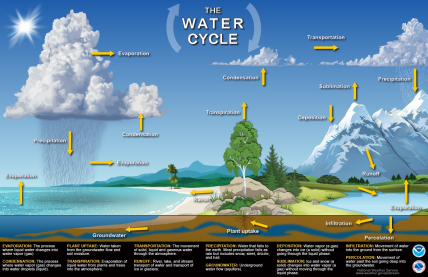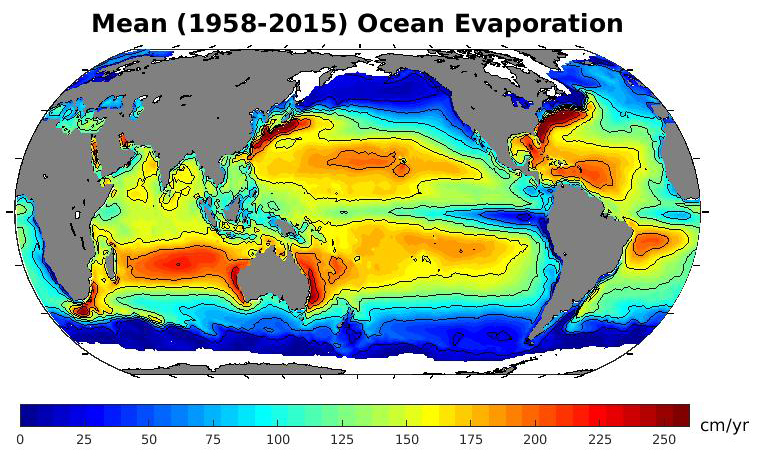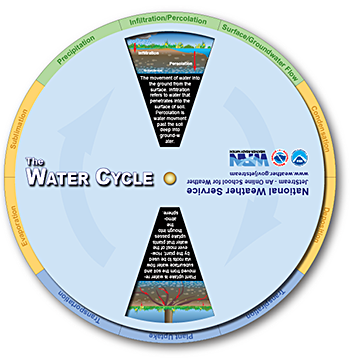
At its core, the hydrologic cycle is water, as a liquid or solid, changing into water vapor (a gas) and back into a liquid or solid. This change of state of water occurs in the atmosphere and between the Earth's surface and atmosphere.
This basic cycle is seen almost daily around the world in the formation and dissipation of clouds. A cloud develops when water vapor becomes a liquid. Conversely, when a cloud dissipates, liquid water changes state back into a gas.
The Ocean's Role
On a global scale, nearly all of the water in the water cycle is in the oceans. The oceans hold approximately 72% of the Earth's water and, because of their size, it may take thousands of years for a water molecule to move from the ocean to the atmosphere. This is in spite of an average 45 inches (114 cm) of water that evaporates from the ocean each year. (An additional 1% of salty water is also found in saltwater lakes and saline groundwater.)
The highest rate of evaporation from the oceans occurs in winter for both the Northern and Southern Hemispheres. The location of greatest evaporation is found on the east coasts of continents. This is due primarily to winter storms that move off the east coasts of continents, which tend to have strong winds. These winds help carry water vapor away from its source, thereby allowing more evaporation to take place.
Another factor is the warm ocean currents that move pole-ward along the east coasts of continents. The cold winter-time air masses that move over the water allow for large differences in air and sea temperatures, so evaporation is also large. When these differences in air and sea temperatures are then combined with strong winds, it makes evaporation in these regions very efficient.
Of all evaporation that occurs over the oceans, a little over 90% of the moisture falls directly back into the sea as precipitation. And after spending upwards of a few thousand years in the ocean, a water molecule, on average, will only spend about nine days in the atmosphere before returning to Earth. This is a very simple water cycle!
Over land, however, the water cycle can become quite complicated. The remaining 10% of moisture is transported over land and falls as precipitation, where it can travel a myriad of paths. If the precipitation falls as snow, it can remain frozen for a day or two, then melt and flow into a river. Or the snow can become compacted and locked up in a glacier for centuries.
Some water may infiltrate the soil or percolate into the groundwater. While most groundwater returns to the ocean, some groundwater can bubble up to the surface as a spring and evaporate back into the atmosphere, flow into a river, or even be captured and bottled for human consumption.
Learning Lesson: What-a-Cycle
Learning Lesson: Water Cycle Paper Craft
Of all the water on the Earth, only 2.5% is fresh water, and nearly all of that fresh water is locked up in glaciers and groundwater. Perhaps surprisingly, the atmosphere only contains about one-thousandths percent of all water on the Earth.
The distribution of fresh water and an estimation of the time a water molecule remains in various features can be seen in the table (below). The Water Cycle chart (above - click to enlarge) shows additional sub-cycles contained within the greater cycle. The USGS also has water cycle diagrams in over 60 languages.
| Location | Total Water (%) |
FRESH Water (%) |
Duration |
|---|---|---|---|
| Ice Caps, Glaciers, & Permanent Snow | 1.74 | 68.7 | > 1000 years |
| Groundwater | 0.76 | 30.1 | ~300 years |
| Soil Moisture | 0.001 | 0.05 | ~280 days |
| Ground Ice & Permafrost | 0.022 | 0.86 | |
| Lakes | 0.007 | 0.26 | 1-100 years |
| Atmosphere | 0.001 | 0.04 | 9-10 days |
| Wetlands | 0.0008 | 0.03 | |
| Rivers | 0.0002 | 0.006 | 12-20 days |
| Humans / Animals / Plants | 0.0001 | 0.003 |



